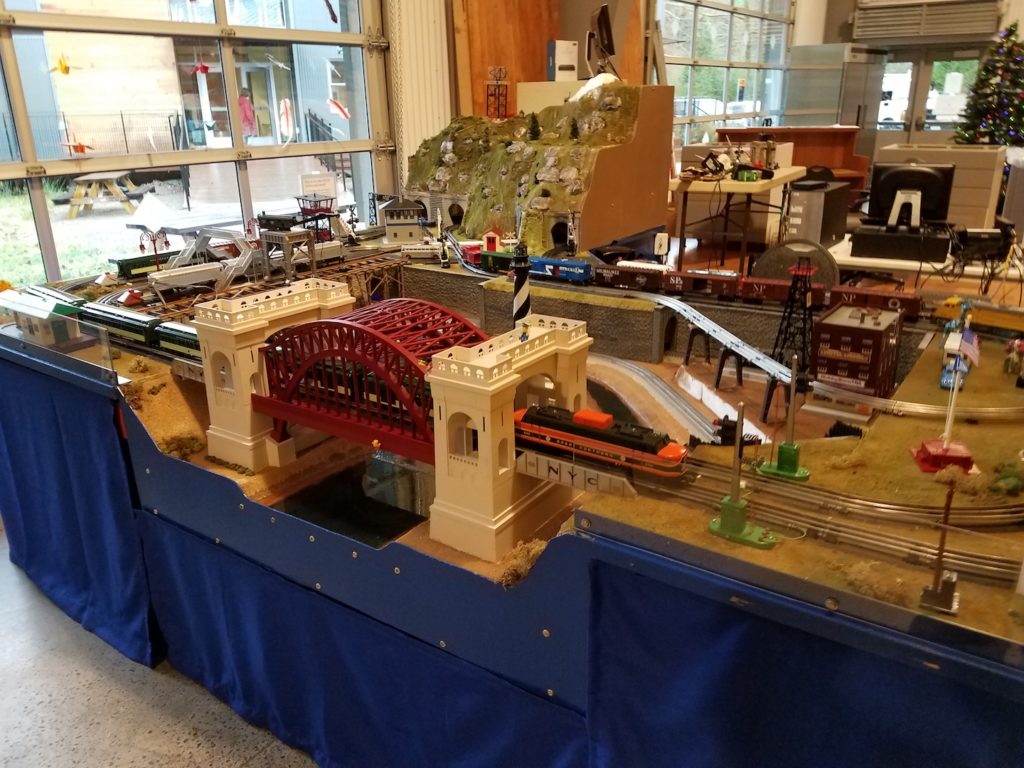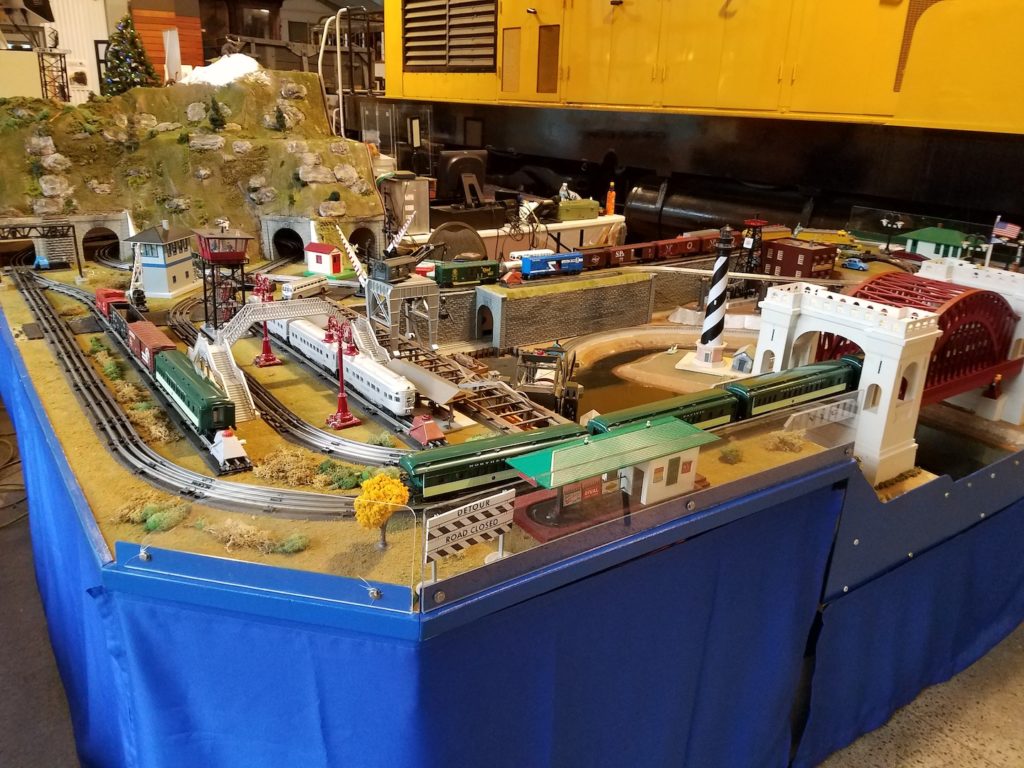Article & Photos By Ed Ives
A request in the Grab Iron called for restoration of an O gauge layout at the Northwest Railway Museum in Snoqualmie, obviously a golden opportunity for the Hi Rail modular group to take action. The layout had formally been in the now defunct Bellingham Railroad Museum and would be resurrected in Snoqualmie. The Hi Railer’s would take on this task.
Contact with Emily Boersma the Museum volunteer coordinator was made to schedule a visit Friday November 20th for a quick assessment of the task at hand. Removing and relocating model railroad layouts might be done in one piece, unlikely, or with a chainsaw, more than likely. Emily advised that the Museum was looking at reopening on December 14th, pandemic allowing and would like the layout up and running by then. Friday came and the visit revealed a layout in essentially one piece, comprising three tracks and needing something like a modular set up at a show. We were advised that running on one of the tracks was never reliable and needs to be fixed. Yes, we can do this no problem. Hum, yes we hope so?
The first work session was scheduled for Tuesday November 24th where the team set about sorting all the tote boxes under the layout into trains, accessories and electrics. A quick look at the locomotives revealed that the mechanisms were dry as a bone and appear to have never been lubricated. A look under the layout revealed a spider work of wiring that was literally cut out to aid transportation, no color coding and any one’s guess as to which goes where. The easiest solution is to rewire, not something we normally do on a show set up. Lubricating locomotives and stock ensued, new color coded power feeders were added to two of the tracks. Soon we were testing locomotives and track. A good percentage of the locomotives needed something more than lubrication, one, a nice Great Northern electric on test made it part way round the layout before stopping in a cloud of smoke. Not good. Well not as bad as it could be as a light bracket in the locomotive decided at that moment to fail shorting out on the frame thus frying the wire. Cut off the wire and the locomotive runs fine but is without a working headlight.
In discussion with Richard Anderson, the museum director, he wished that by the 14th we have all three tracks in full reliable operation, all accessories working. As he said, he would like to see light and action. There is no evidence of previous automatic operation of signals nor barrier crossings and it would appear such operation would be desirable in the future. It was decided that this feature would be put on the back burner and handled in the New Year after everything else is fixed and operational.
December 1st was the next work session. Having gone through all the locomotives, lubricated all, repaired some and others put away for a more extensive overhaul. We moved on to the accessories to check them out, each showing evidence of extensive use. The lower inside track had been glued in place but about a six foot stretch had come adrift. The loose track was screwed down. The track was cleaned as best we could considering there are two tunnels on the line where the track is inaccessible within. Our first attempt to run a train on this track had the locomotive enter the tunnel at full gallop and derail out of sight and out of reach. Consistent running was finally accomplished by all locomotives on all tracks except for Thomas the tank. The wheel bearings on his passenger cars were so worn, through lack of lubrication, that the wheel flanges were scraping on the underside of the car floor. The drag of these cars causing Thomas to derail on the corners. The Museum did not consider they wished to buy new cars as would be reasonable. We offered to take these cars away to see if we could accomplish a repair as they are less than useless otherwise.
December 4th revealed the Thomas passenger cars with new brass bearings replacing those original Lionel plastic ones. Thomas now runs fine. GREAT!!!! The rest of the day was devoted to powering the lights, accessories and compiling a list of spare parts required.
December 8th and in what we thought would be the final day of work before the 14th taking our stock of new light bulbs and parts for repair of ailing accessories. Work was progressing in fine order even to a bit of beauty treatment to the scenery when Richard dropped by with the disheartening news of an extension of the lock down to January 4th and that the museum would remain closed through then. Not a huge surprise but obviously a hit to the museum with lost revenue during the holiday season. A quick assessment of our ‘plan’ showed that a revision was needed, we cannot justify delaying automation of the accessories until January and in reality that should be accomplished prior to Christmas. The rest of the work session was devoted to testing the signals as well as the barrier crossings for operation. As with most other parts of this layout few worked as is and by the end of the day by a means of cannibalization the three required functional barrier crossings were made out of seven nonfunctional ones. Neither of the signals were functional and both needed new components to make functional. It is doubtful that we can source parts locally considering these signals are at least 50 years old. Where is the Boeing swap meet when you need it?
December 11th, the final day and big push to put this program to bed with four members working on the layout; two servicing reluctant accessories; one under the layout wiring for the barrier crossings; one doing the final scenery touch ups and all tidying up around the layout. One of our members raided his home layout for a couple of color light signals set for automatic block operation that he donated to the project. These were added to the layout in the final minutes of the session. We have now been made official museum volunteers and need to sign in and sign out. A little training session will be required for other museum volunteers in how to operate the layout; put it to bed at the end of the day and awaken it in the mornings.


Overall it was nice meeting and working with Emily and Richard; good to work on a layout again and not quite like a set up at a train show. It was a learning experience especially in automation that we might add to our modular layouts. On the negative side if there was one, the floor of the building was darned cold and hard.
Ed Ives

Excellent report. Thanks a bunch for helping to inspire future and current model train fans.